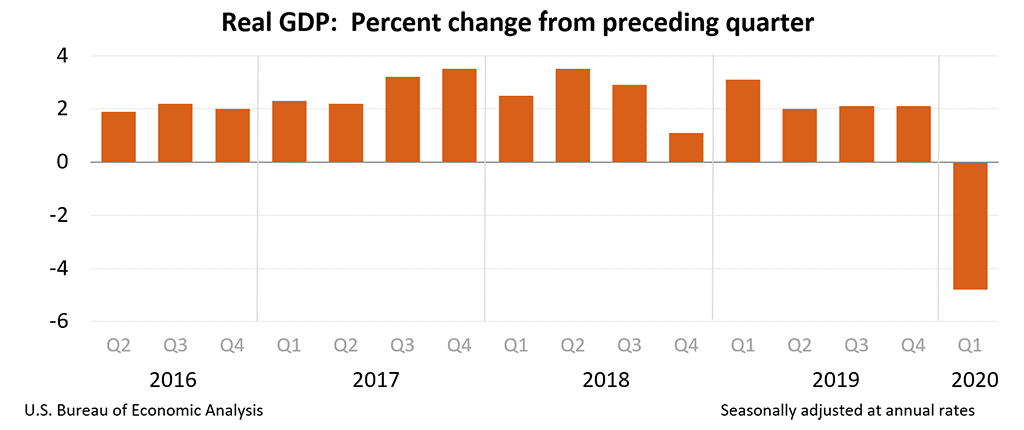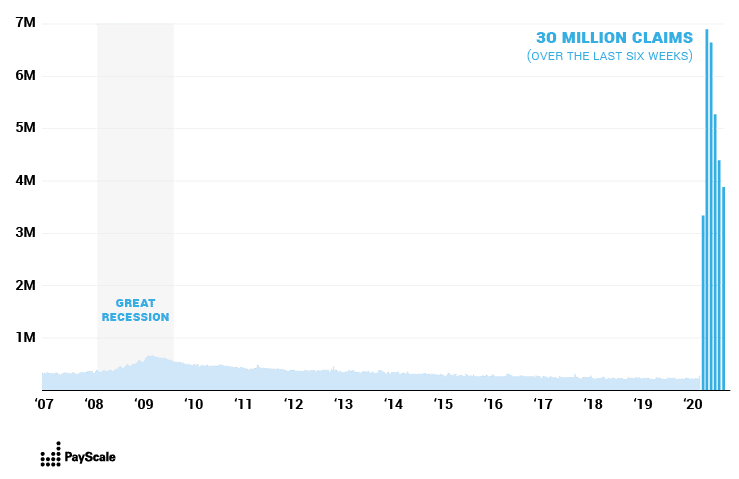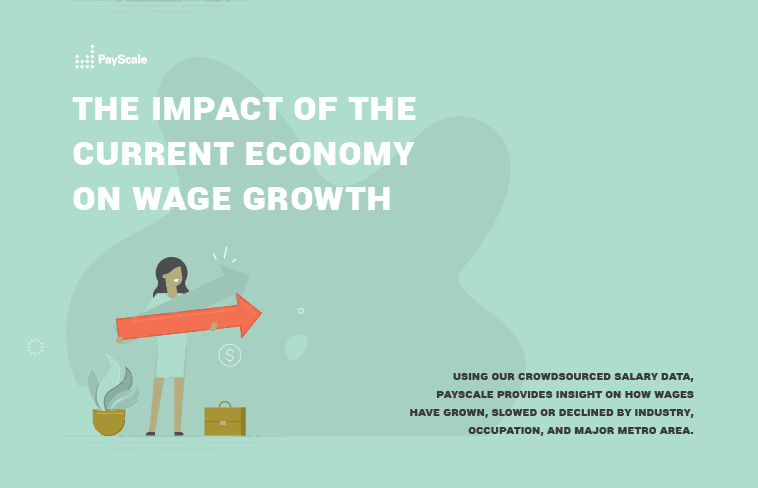The results are in. Analysts have been guessing how much the US GDP has fallen as a result of the coronavirus pandemic for weeks, but we finally have the answer. The U.S. Bureau of Economic Analysis (BEA) published its advance report of GDP growth in Q1 on April 29, 2020.
The verdict? U.S. GDP has fallen -4.8 percent in Q1 of 2020.

For context, this is less of a drop than the worst quarter of the Great Recession, where GDP growth fell -8.4 percent in Q4 of 2008. However, Q1 is not going to be our worst quarter in 2020. Unemployment has been most severe in April, so we won’t really know the impact of the coronavirus pandemic on the GDP until the advanced report comes out for Q2, which won’t be until the end of July. These numbers may also change later in the year when final reports are released.
Given how fast the economy is changing, knowledge is everything. Businesses need to be able to forecast the impact of the decisions they have to make and once they’ve made those decisions, they want to see immediate results.
This requires fresh, accurate, actionable data.
In the realm of compensation, we can help.
The Value of Fresh Compensation Data
In a recent webinar, we explained how PayScale’s compensation data is the freshest in the market and can help HR leaders, compensation professionals and business owners manage the workforce when the economy is in flux. Specifically, our software solutions can help businesses price jobs according to job titles, locations, skills, education, experience, and other compensable factors.
Our compensation management software also helps organizations identify employees who are underpaid (green-circled) or overpaid (red-circled) compared to the market, identify pay inequities within the organization, manage third-party survey participation, and evaluate how employees are compensated against performance programs.
This is really useful to businesses who understand the impact that compensation has on employee morale and how critical morale is to being a company that not only survives a recession, but thrives afterward.
Watch the webinar: Deciphering Data: Using Crowd and Company Sourced Data to Navigate Ahead
Free Data Promotion for a Limited Time
Because of the seriousness and uniqueness of the situation caused by the coronavirus pandemic, PayScale is currently running a promotion. For a limited time, our Crowdsourced and Company Sourced data — the freshest on the market — is free to both new and existing MarketPay customers.
This offer is particularly exciting for compensation professionals who may currently be relying solely on third party market survey data (which can be more than a year out of date) and may be less experienced with our Crowdsourced data methodology. The promotion allows for compensation professionals to experiment with both Company Sourced and Crowdsourced salary data (which is validated in multiple ways and has been verified as accurate through third party survey comparisons) while also making management of surveys easier through MarketPay’s survey management tools.
The promotion is available through the end of June and free access to PayScale’s Crowdsourced and Company Sourced data will continue for one full year.
Get the goods: Learn more about our free data promotion.
Thought Leadership on Wage Growth
Because of the robust quality of our data, PayScale is able to conduct statistical analysis and provide data and insight on compensation best practices as well as wage growth, which we publish quarterly in our PayScale Index Report.
Recently, we also analyzed wage growth data year-over-year and month-over-month to get an understanding of the impact that the coronavirus and the economic downturn is having on wages. For example, in comparing wage growth data between February and March in 2020, we found that the average wage growth across industries declined -0.7 percent.
Download the full report: The Impact of the Current Economy on Wage Growth.
The Top and Bottom Jobs for Wage Growth in Early 2020
To add color to our wage growth report, we also looked at which jobs are seeing the most wage growth and which are seeing the least wage growth. This data compared wage growth from March 2019 to March 2020.
Note: When we look at wage growth data by individual job titles, we have to be cognizant that rankings depend on how we categorize jobs as well as how many profiles we have for each job. Some jobs are more prolific than others, giving stronger signals and greater statistical validity. To make sure we are looking at raw numbers with enough statistical significance, we require at least 100 profiles on a specific job for it to qualify in the rankings.
Given that caveat, here are the jobs experiencing the greatest declines in wage growth year over year:
| Bottom 20 Job Titles – Wage Growth | YOY Growth | Salary Median |
| Assistant Manager | -8.2% | $32,100 |
| Information Technology (IT) Manager | -5.9% | $81,600 |
| Automotive Service Technician / Mechanic | -3.3% | $39,200 |
| Assistant Store Manager | -3.1% | $34,200 |
| Charge Nurse (RN) | -2.7% | $71,700 |
| Pharmacy Technician | -1.8% | $30,800 |
| Warehouse Manager | -1.7% | $47,800 |
| Carpenter | -1.6% | $46,700 |
| Field Service Technician | -1.2% | $47,700 |
| Information Technology (IT) Director | -1.2% | $124,000 |
| Physical Therapist Assistant | -1.2% | $55,200 |
| Office Administrator | -1.1% | $39,900 |
| Data Scientist | -0.8% | $98,400 |
| Property Manager | -0.5% | $47,600 |
| Registered Nurse (RN), Critical Care | -0.4% | $69,500 |
| Systems Administrator | -0.4% | $61,800 |
| Account Manager | -0.3% | $56,100 |
| Paralegal | -0.2% | $46,000 |
| Customer Service Representative (CSR) | 0.2% | $32,100 |
| Senior Business Analyst | 0.4% | $91,800 |
Analysis: Bottom Jobs
In looking at the bottom 20 jobs with the least wage growth, there are some expected appearances and some surprises.
A drop in wages for Assistant Managers and Assistant Store Managers likely reflects the reduction in shopping in the month of March as well as the eventual closure of brick and mortar retail stores in some areas of the country. Automotive service technicians also likely saw lower wages for a similar reason — less work as fewer people were driving.
Contrary to popular opinion or expectation, some healthcare positions have also experienced a decline in wage growth. Charge Nurses, Registered Nurses in Critical Care and Pharmacy Technicians are all in the bottom 20 for the month of March. Although hospitals have been beleaguered with coronavirus patients, many other services have dwindled or been shut down, including elective surgeries, which are responsible for much of a hospital’s revenue. In addition, people who might otherwise go to the doctor to seek treatment and remedies have been more likely to forego those appointments – or had them cancelled – due to fear of contracting or spreading the virus. Collectively, this can have a negative impact on wages in healthcare.
Other positions on the bottom 20 list that might be surprising include IT Managers, IT Directors, Data Scientists, System Administrators, and Senior Business Analysts. Wages for technology positions have been trending up in recent years and the need for IT services to support digital transformation and remote working conditions should have been rising in the month of March. However, businesses that were starting to look ahead may have taken measures to freeze or cut wages for some of their highest paid positions in order to stabilize payroll. In addition, managerial positions sometimes tend to lag behind in wage adjustments than individual contributor roles.
Senior Business Analysts are actually still seeing wage increases, just at a lower percentage than previous years. Indeed, most jobs are still seeing wage increases in 2020.
Here are the top 20 jobs with the most wage growth year over year:
| Top 20 Job Titles – Wage Growth | YOY Growth | Salary Median |
| Information Technology (IT) Support Specialist | 15.4% | $52,200 |
| Civil Engineer | 11.3% | $73,200 |
| High School Teacher | 9.2% | $54,300 |
| Accounting Manager | 9.0% | $78,000 |
| Case Manager | 8.7% | $42,500 |
| Retail Sales Associate | 8.5% | $25,800 |
| Sr. Software Engineer / Developer / Programmer | 8.1% | $121,000 |
| Delivery Driver | 8.0% | $34,000 |
| Human Resources (HR) Specialist | 8.0% | $51,700 |
| Legal Assistant | 7.9% | $41,900 |
| Patient Care Technician | 7.8% | $31,200 |
| Design Engineer | 7.4% | $71,900 |
| Laborer | 7.3% | $34,900 |
| General / Operations Manager | 6.9% | $63,400 |
| Registered Nurse (RN), Operating Room | 6.8% | $74,100 |
| Executive Assistant | 6.7% | $57,200 |
| Director of Operations | 6.6% | $100,000 |
| Software Developer | 6.2% | $77,800 |
| Certified Medical Assistant (CMA) | 6.0% | $34,700 |
| Data Analyst | 6.0% | $63,400 |
Analysis: Top Jobs
Again, with this listing some jobs with the most wage growth are expected and others are surprising — or even contradictory to the bottom 20 listing.
Included in the top 20 jobs with the most wage growth year over year are IT Support Specialists, Sr. Software Engineers, Software Developers, and Data Analysts. In other words, some of the most highly paid positions in technology are seeing wage declines (except for developers), especially managers, while for individual contributors in IT, wages are rising. This is likely because it is easier to secure wage increases for individual contributors than for management, and many people in individual contributor positions within IT have been working overtime to meet demand. The same is probably also true for Retail Sales Associates and Delivery Drivers, especially in industries seeing surges in demand.
Among healthcare practitioners, Patient Care Technicians and Certified Medical Assistants saw some of the highest gains. This is likely tied to the relatively low median wages for these positions compared to, for example, nurses, which are more difficult to secure pay raises for. This may change substantially in April.
Another interesting profession on the top 20 wage growth list is High School Teachers. This is likely less related to the coronavirus than legislation in several states to increase compensation for teachers in 2020 after a year of protest rallies and walkouts in 2019.
Finally, wages are also growing notably for HR and Operations, including Directors of Operation, all of which are experiencing enormous amounts of stress as business operations shifted to work-from-home models and all eyes turned to HR for help managing the workforce in this unprecedented situation.
Wage Growth in the Future
In normal circumstances, wages tend to increase over time, even if they fluctuate month to month. In the current economic climate, with a recession on the horizon, employees still need fair pay in exchange for their time and expertise. Even in this unprecedented situation, wages may continue to creep upward, if more slowly than they did during a booming economy, and at different rates and degrees for different markets, industries and occupations.
Wage growth for April is still unknown, but we will be able to report on this data soon — faster than anybody else — and we expect it to be interesting given that over 30 million people have filed for unemployment in the month of April.

For richer analysis on jobs with the most wage growth across the U.S. by industry, occupation, and major metro market year over year and month to month at the beginning of the downturn, download our most recent whitepaper: The Impact of the Current Economy on Wage Growth.

Do you want to be able to keep track of jobs with the most wage growth? Interested in our compensation management software? Request a demo.



